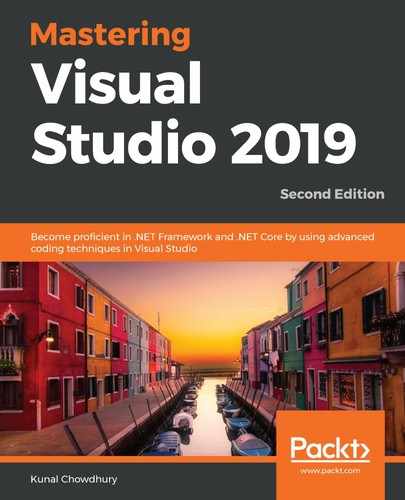Book Description
Explore the new features in Visual Studio 2019 and build apps using WPF, .NET Core, TypeScript, and Azure
Key Features
- Learn how to write better code with the new and improved Visual Studio 2019 toolset
- Accelerate cloud development with built-in Azure tools
- Collaborate with a distributed team by integrating Visual Studio with source control repositories
Book Description
Visual Studio 2019 is the latest IDE from Microsoft for developers targeting Windows and other platforms to build stunning desktop, web and mobile applications. In this book, you'll learn how to effectively use this IDE to build, debug, and test your applications to enhance productivity by simplifying your most common tasks and allowing more time to focus on other aspects of your project.
Starting with an overview of the new features in Visual Studio 2019, you'll understand what's improved since its previous edition. This Visual Studio book will help you build applications for Windows using Windows Presentation Foundation (WPF), which provides a unified programming model for developing dynamic, rich, data-driven desktop applications. You'll then learn about Microsoft's implementation of cloud computing with Azure, followed by building applications using .NET Core and TypeScript. This book will also help you explore NuGet, the package manager for the Microsoft development platform, that enables you to create, publish, and consume packages from a central repository by managing a reference list of packages. Finally, you'll delve into the debugging and live unit testing techniques that are built into the IDE.
By the end of the book, you'll have become a more efficient Visual Studio 2019 user, and be able to use it for developing, testing, debugging and deploying your applications.
What you will learn
- Increase your productivity with Visual Studio 2019's new features
- Understand how the installation wizard works and create an offline installation package
- Build stunning applications using WPF, .NET Core, and TypeScript
- Explore NuGet packages in depth
- Accelerate cloud development with Azure
- Debug and test your applications efficiently
- Get to grips with integrating Visual Studio with Git repositories
Who this book is for
If you're a Microsoft .NET developer who wants to learn the new features of Visual Studio 2019, or want to delve into cloud computing, .NET Core, TypeScript along with mastering the skills of building, debugging, and unit testing professional apps, you'll find this book useful. Basic knowledge of Visual Studio, .NET, and C# is assumed.
Downloading the example code for this ebook: You can download the example code files for this ebook on GitHub at the following link: https://github.com/PacktPublishing/Mastering-Visual-Studio-2019-Second-Edition. If you require support please email: [email protected]
